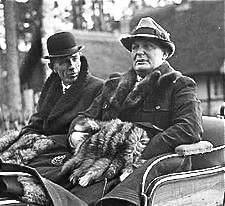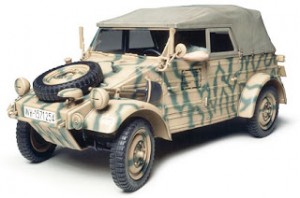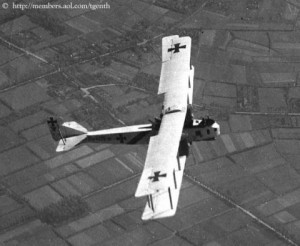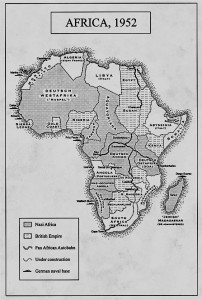“Dunkirk had shown [the British] that they were no longer invincible. Peace with Herr Hitler may not have been the country’s finest hour, but it had preserved their way of life. Brought security for their neighbors under the Council of New Europe. If they clashed with the Germans over Africa, war might erupt again. Homes bombed, thousands slaughtered. And for what? To preserve the French colonial legacy?”
 In this alternative history set in 1952, debut author Guy Saville assumes that the negotiations of Lord Halifax, a British advocate of appeasement throughout the war, has led ultimately to détente between Great Britain and Germany. In 1943, the two countries, wanting to avoid war, had met at the Casablanca Conference and agreed to divide the African continent into two spheres of influence. The divisions would be primarily along the historical colonial lines: West Africa would remain largely under German rule, with Kongo, Kamerun, Dutch East Africa (present day Tanzania), Nazi-occupied Angola, SW Africa (now Namibia), and Madagaskar also part of the German sphere. Sierra Leone, the Gold Coast, Nigeria, Egypt, Sudan, Kenya, Rhodesia, and Bechuanaland (now part of S. Africa) would remain under British rule. Morocco (under Spain); Algeria (under Vichy France); Libya, Somalia, and Abyssinia (under Italy); northern Angola and Mozambique (under Portugal), and South Africa (neutral) would continue under their existing governments. The island of Madagaskar, off the coast of Mozambique, would become “Jewish Madagaskar,” a “Jewish homeland” administered by the SS.
In this alternative history set in 1952, debut author Guy Saville assumes that the negotiations of Lord Halifax, a British advocate of appeasement throughout the war, has led ultimately to détente between Great Britain and Germany. In 1943, the two countries, wanting to avoid war, had met at the Casablanca Conference and agreed to divide the African continent into two spheres of influence. The divisions would be primarily along the historical colonial lines: West Africa would remain largely under German rule, with Kongo, Kamerun, Dutch East Africa (present day Tanzania), Nazi-occupied Angola, SW Africa (now Namibia), and Madagaskar also part of the German sphere. Sierra Leone, the Gold Coast, Nigeria, Egypt, Sudan, Kenya, Rhodesia, and Bechuanaland (now part of S. Africa) would remain under British rule. Morocco (under Spain); Algeria (under Vichy France); Libya, Somalia, and Abyssinia (under Italy); northern Angola and Mozambique (under Portugal), and South Africa (neutral) would continue under their existing governments. The island of Madagaskar, off the coast of Mozambique, would become “Jewish Madagaskar,” a “Jewish homeland” administered by the SS.

Setting much of this novel in German Kongo, author Saville, focuses on Germany’s longer range plans for “Afrika.” They have already shipped most of the black population from their colonies to Muspel, a huge, undeveloped desert area in German West Africa. Remaining behind are those Africans who can be used as forced laborers, under German colonial overseers trying to outdo each other in creating autobahns, elaborate edifices in marble or special concrete (created through their own formula), and communications systems throughout the “empire.” When Donald Ackerman, a Brit, appears at the home of Burton Cole, a former French Foreign Legionnaire, now retired in rural England, he is representing “interests in Northern Rhodesia,” specifically the Lukasa Mineral Concessions. He makes a case to Cole for the assassination of Walter E. Hochburg, now the Governor General of Kongo. For undisclosed reasons, Cole is anxious to see Hochburg dead, but not before he has had a chance to interrogate him about issues close to his heart. Reluctantly, he accepts the job, promising Madeleine, the woman who will bear him a child in a few months, that he will be back in a few weeks.

Lord Halifax (left) with Hermann Goering, 1937
In a dramatic opening scene, Cole arrives in Kongo disguised as an SS surveyor, traveling to the Schadelplatz, in the capital of Stanleystadt, in which the square is paved with twenty thousand skulls. Meeting with Hochberg, Cole stabs him to death, then escapes with some of his co-conspirators, only to discover later that Hochberg is somehow alive.
With a team consisting of six fighters, including Burton Cole (British); his best friend, Patrick Whaler (American); and Dolan (from Wales) among others, Cole is determined to finish the job and then get back home to Madeleine. As the six men try to escape from Kongo after their failed assassination attempt, they divide into two groups, with Burton Cole, Patrick Whaler, and Nares (a pilot and diamond smuggler) heading west toward Nigeria, and Dolan, Vacher (Rhodesian), and Lapinski (Polish) toward Sudan. As the two groups do everything imaginable to escape from Kongo, Hochberg and his men are in hot pursuit, willing to stop at nothing, knowing that if they can get one group, they have a chance of getting the information they want through gruesome tortures.

The Kubelwagen built by Porsche, shown here, was used as the author's prototype for the Ziege "Jeep," a transport used in the novel.
Eventually Burton Cole and his group connect with the resistance in Angola, and meet Neliah and her sister Zuri, two brave, black women who are anxious to get the Germans out of their country. These women feel that they have absolutely nothing to lose, since the Germans are also occupying their country and committing atrocities.
Reading this novel is like reading a movie. The action is so graphic and so cinematic, that it is easy to imagine a hardcore action thriller, peopled with characters as impervious to pain as Superman. By the halfway point, Burton Cole and Patrick Whaler have been beaten, stabbed, slashed, smashed, and tortured to what would be the breaking point if these bigger-than-life men could be broken. No matter how much they are abused, they remain true to their goals. Whether one has a broken femur, a broken nose, burns, or eyes swollen shut because someone has ground a hot pepper into them, none of these men give in. About a dozen dramatic, over-the-top scenes in which they somehow manage miraculous escapes have taken place, and there are even more such episodes to come in the second half.

The Gotha plane, used for bombing in World War I, was modified and still in use during World War II. One of them appears in this novel.
Throughout all this torture, the incredible escapes, near misses, and captures, the author’s focus is on the action. Though the rationale for this action, based on the author’s research into the Reich’s possible plans for Afrika, may be partially spelled out, we know almost nothing specific about the Germans’ long-range plans for the continent or about most of the characters, only as much as we need to know to keep them from becoming confused with each other. The characters of Cole and Whaler, comrades from their French Foreign Legion days, ultimately become stereotypes of brave fighters willing to risk all for what is good and right, while the Germans are as evil as one can invent. Ultimately, the reader reads for the excitement of the chase – and misses and near-misses – and not because of any personal identification with the characters. The author has done his homework in terms of setting the stage for the action, but the action itself reflects little of the depth one would hope for in a four hundred-page novel in which the action could have been connected more directly to the overall plans of the Nazi colonizers. Saville is an exciting new author with a suspenseful, dramatic style, and I’ll be hoping for more depth of character and more fully developed motivation to bring his future novels to life.
Photos, in order: The author’s photo is from http://www.echo-news.co.uk
The Lord Halifax and Hermann Goering photo appears on http://en.wikipedia.org
The Kubelwagen by Porsche, used as prototype for the Ziege Jeep, is seen on the author’s blog http://guysavillewriter.blogspot.com
The Gotha plane may be found on http://airminded.org
The Africa 1952 map, as imagined by the author, appears in the front of the novel. The darkest gray represents German interests. The dotted gray countries are British. The lightest are the interests of Italy, Portugal, and Spain.
ARC: HHolt
